Page created:
29-Jun-2007
Last update:
8-Jul-2007
www.miketodd.net
© 2007
Mike Todd
Jim Butterfield (1936-2007)
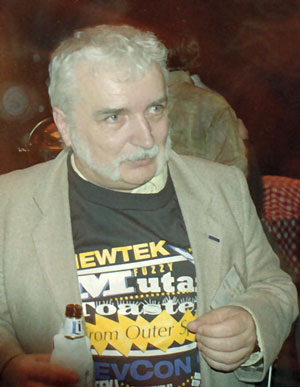 Anyone
who took their Commodore computer at all seriously will have known the
name Jim Butterfield, or at least encountered his prolific writings
in magazines or his own books, his appearances on television or his various
appearances at computer clubs and shows. Jim was a (if not the)
major celebrity in the world of Commodore.
Anyone
who took their Commodore computer at all seriously will have known the
name Jim Butterfield, or at least encountered his prolific writings
in magazines or his own books, his appearances on television or his various
appearances at computer clubs and shows. Jim was a (if not the)
major celebrity in the world of Commodore.
Sadly, after a very courageous battle with cancer, Jim died in Toronto in the early hours of 29th June, 2007.
Jim was at the heart of the "Commodore scene" in the 70s, 80s and 90s, an honorary "Brit", and a friend to many Commodore users. This is a somewhat personal tribute to the Jim Butterfield that I knew over those decades.
An Honorary Brit
Jim was born on Valentine's Day in 1936, in Ponoka, Alberta, a small town
60 miles south of Edmonton, but he spent much of his early childhood in
England.
Jim's parents were both born in England (his father's roots were in Bradford, Yorkshire, and his mother's in Lancashire) and, as a toddler, Jim (and his brother and sister) was taken back across the Atlantic for a family reunion.
But World War II got in the way, and they all found themselves stranded.
To earn a living, Jim's father ran a milk round, and they lived in Morecambe, where Jim's younger sister, Margaret, was born.
Eventually, Jim and the family were able to return to Canada, where he continued his education, eventually studying mathematics and electronics.
While Jim's first "real" job was as a continuity script writer for radio stations back home in Alberta, writing the words (including the commercials) that the announcers would say, his career in computers and electronics really started when he was about 20. He got a job with the Canadian railways at a communications site in the remote Canadian town of Whitehorse, Yukon, some 500 miles east of Anchorage, Alaska.
It was in his time in the Yukon that Jim started to exercise his flair for writing, and where he wrote his first magazine article. It appeared in Popular Electronics in August, 1959, and was about the theory of the new-fangled transistor.
His skills as a communicator were recognised and he ended up looking after training for the microwave engineers.
But in 1963, Jim's electronics career took a shift sideways when he encountered his first computer, the company's mainframe, a Collins C8401, and was taught to program it in assembly-language using a language called COGENT. Later he moved on to his second computer, the company's IBM 1401 mainframe.
Then his career took another sideways leap - Jim ended up in the marketing department.
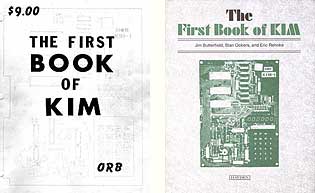 Jim
meets Commodore
Jim
meets Commodore
In 1975, MOS Technology introduced a small, single-board computer, called
the KIM-1 (standing for "Keyboard Input Monitor"). It
was designed by a gentleman called Chuck Peddle, and used MOS Technology's
6502 processor. Although it was really just designed to demonstrate the
capabilities of the processor, within a year the KIM-1 had many computer
enthusiasts excited - and, of course, one of these was Jim Butterfield.
These first microcomputers, while very crude by current standards, were little marvels of their time, and there was a lot to be discovered and passed on to those new to the technology. Although by now Jim was a skilled programmer (he had, for instance, written a complex railway reservation system for his company), he used his enquiring mind to investigate the KIM-1.
So it was that in 1976, Jim co-edited "The First Book of KIM", which was first published privately in 1977, and the following year was published by the Hayden Book Company of New Jersey.
Jim, and his co-editors, Stan Ockers and Eric Rehnkey (the O and the R on the 1977 cover) dedicated it "to the person who just purchased a KIM-1 and doesn't know what to do with it". Jim wrote many of the games, diagnostics and utility programs featured in it, and the book became an excellent example of how to explain and demonstrate to others just how a small computer worked and what it could do.
By the time this was published, MOS Technology (including Chuck Peddle) had been bought in its entireity by Commodore Business Machines, and the KIM-1 effectively became Commodore's first computer. Up until this point, Commodore had been making office furniture and calculators, and now that they owned a computer chip company, Peddle was able to persuade CBM's owner, Jack Trameil, that computers were the future, and he was allowed to take the KIM-1 design and expand it, adding a display, keyboard and cassette ... and, in 1977, the Commodore PET-2001, complete with a built-in BASIC language interpreter, written by Microsoft, was born.
Needless to say, Jim jumped head-first into the new computer, literally and figuratively taking the lid off to see how it worked. He disassembled the system code and soon published an annotated listing showing how it worked. This was at a time when I was doing the same thing, but Jim beat me to the final result. We were soon exchanging letters (there was no email, of course, in those days), and this was the start of my real acquaintance with the "Commodore guru".
By this time, PET owners in the USA, Canada and UK were getting together, and the seeds of a larger social network were sown. Jim was living in Toronto by this time, where he was in at the birth of TPUG (Toronto PET Users' Group) which soon became one of the two leading Commodore groups in the world. TPUG became a regular haunt for Jim, where his easy-going style and understandable explanations made him a popular speaker.
Commodore continued to develop the "PET" range, with every new model creating a new opportunity for Jim to go diving under the bonnet ("hood" for our American friends) and produce articles and software for the new machines.
A full-time expert
By this time, Jim had become a prolific writer (both of articles and useful
bits of software), with close ties to Transactor magazine (a Toronto-based
magazine for Commodore computers), and when the company he had worked
for for nearly 25 years decided to move its base out of town, Jim decided
that commuting would eat into his computing time. So he quit to become
a "full-time computer guru" (although that's not quite how Jim
would have described himself).
Not only did he write and make personal appearances, he even appeared on television. The images below were taken off-screen from the 1984 Canadian TV show The Academy, aimed at computer novices - this particular show was about floppy-disk drives.







Jim in Person
My first personal encounter with Jim was in the summer of 1984.
Jim and I had been corresponding over various matters for a few years, often with a sense of playful rivalry, and I always looked forward to his replies. More recently it had been about the newly-released 1541 floppy-disk drive, designed for the VIC-20 and its successor, the Commodore-64. Following a number of articles that I'd written on how the drive worked, I was invited to talk at a computer summer camp in Brandon, Manitoba, at the begining of July, 1984 - and Jim Butterfield was also to be there.
It was a thrill for me to meet him in person, and an honour to be working alongside him.
Jim proved to be just as amiable as he came across in his letters and articles, with a great sense of humour, and a patience befitting a good teacher. And above all, he always knew interesting places to go to visit or eat!
During the week of lecturing, he announced that we should have an outing to Spirit Sands, part of the Spruce Woods National Park, and when we got there he proceded to tell us all about the dinosaurs that had roamed there.
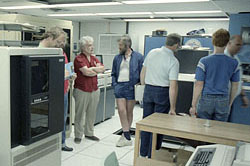
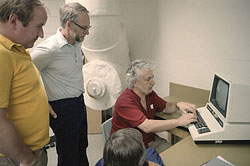
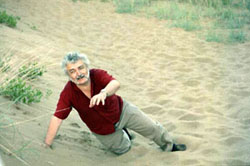
The first two of these pictures show Jim in his element ... always willing to stop and answer questions ... and the third is Jim demonstrating how to survive in the desert!
The following week, Jim was due to lecture down in Lincoln, Illinois, at another computer summer school.
He got me an invitation to run a class on machine-code programming, and together we flew down to Chicago, where we stayed overnight before getting the train to Lincoln. He took me on a walking tour through some of the seedier parts of the city, carefully engineering it so that we passed the "Michael Todd Theatre"!
We stayed at the Holiday Inn, where I had my first taste of the joys of the American "Sunday brunch" ... we started at about 11am, and were still there eating, chatting and reading the newspapers at 3pm!
After our week at Lincoln, I accompanied Jim as he went back to Toronto. There, he introduced me to the staff of Transactor which, one of my young students had pointed out, had reprinted a series of my articles on Basic without my permission. Jim gently raised the subject with them, and negotiated a decent fee on my behalf - although I don't recall giving him his 10%!
Members of the users group, TPUG, treated me to a meal at Mr Greenjeans, and at the end of the meal Jim announced that he'd ordered me dessert - a Top Hat. This was a perspex top hat, filled with ice-cream, whipped-cream, M&Ms, marshmallow bits, and just about every other confection you could imagine, and topped with hot fudge. The deal was - eat it all by yourself and the second one is free! Needless to say I didn't finish it, and Jim and his friends dived in and finished it off for me.
Jim in the UK
As the Commodore world expanded, with the Commodore-128 and the various
models of Amiga, Jim was always one step ahead. He had developed an extremely
close relationship with Commodore (Canada), and was often taken into their
confidence as new machines were being developed. Indeed, he was sometimes
used by Commodore as a consultant, sometimes accompanying them on their
stands at various computer shows.
He was to be seen at many a computer club in America, Canada and the UK, and would usually include a visit to Bradford, his father's family home, when he came over.
At one of the computer shows in England, Jim announced that was was going to take a group of us on a tour of Wapping High Street. Those of who lived or worked in London simply couldn't figure out why. But it soon became clear - Jim knew a lot about the history of the area and regaled us with stories that I suspect many of the official London guides didn't know. We ended up at the very old Prospect of Whitby pub, overlooking the Thames and a noose, with Jim regailing us with stories of Judge Jeffries, the so-called "Hanging Judge", who frequented the pub in the 17th century.
On another occasion, we were walking in a park along from the Houses of Parliament, and Jim diverted us towards an old building, and down some steps and a nondescript door. Inside was a little-known wine bar, frequented only by those who knew it was there.
We never did figure out whether all of this was genuinely something he just knew, or whether his presentation skills had him researching for his audience the day before!
Jim was one of the few people who, back in the 80s, really understood how important it was to introduce children to computers at an early age. It was evident in his relationship with young people at the computer school in 1984 ... his rapport with anyone who showed an interest was legendary, but he seemed particularly at home with the youngsters.
Jim married Vicki, and in 1988 their daughter, Susannah was born. Jim suddenly took a back seat in the computer world as he devoted his life to his new daughter. But he didn't stop altogether, and would still be seen at shows, developers' conferences and at user groups.
Then, in 1994, Commodore went bankrupt and sold off its assets. The Commodore 64 and Amiga did continue in one form or another, and Jim was occasionally seen writing and speaking about the PC!
In the summer of 2006, we learned that Jim was undergoing chemotherapy. He said at the time that they had never given him a real diagnosis, but by the end of September he was undergoing a second round.
He issued occasional "bulletins" to a circle of friends, which became a daily occurrence. Despite his undergoing chemo after chemo, and going through a number of setbacks, Jim's sense of humour was always in evidence. But the treatment eventually made it harder and harder for him, and it was his wife, Vicki, who continued to keep us informed of his progress. Sadly, Jim' deteriorated a few days ago - she reported that things were getting worse, and that the prognosis wasn't good.
Jim died peacefully in Toronto in the early hours of 29th June.
Jim was a mentor to many people, a celebrity to some, and few could meet him without something of him rubbing off - even if it was just his sometimes bohemian appearance, or his unique style of presentation. Although we lost touch over the later years, I considered Jim a very good friend and, like many others, owe him a lot.
CAVEAT: The above was originally written nearly ten years ago and brought out of storage on the sad news of Jim's death. Original sources have long been lost, and I've not had time to double check all the information If you feel that there's anything to correct, or indeed anything worth adding, please let me know. As a result, please don't use the material without checking with me first, but feel free to link to the page.
REVISIONS:
1-Jul: thanks to Betty Clay for providing some background on Jim's
family, and correcting where the family lived during WWII.